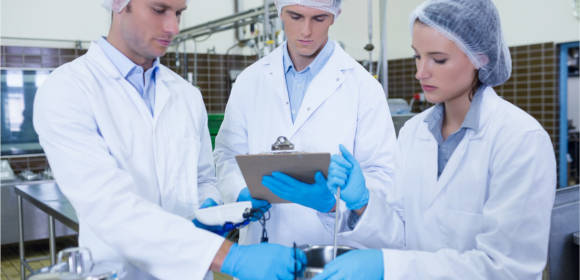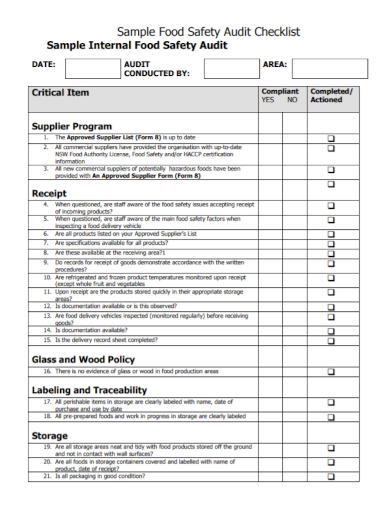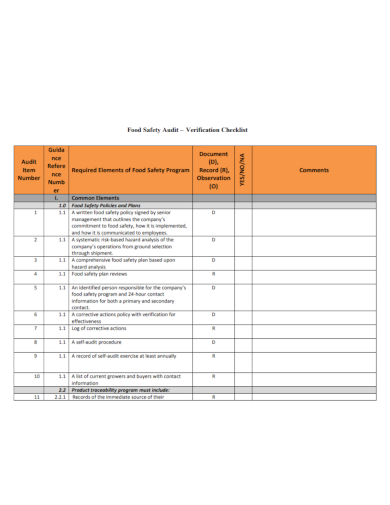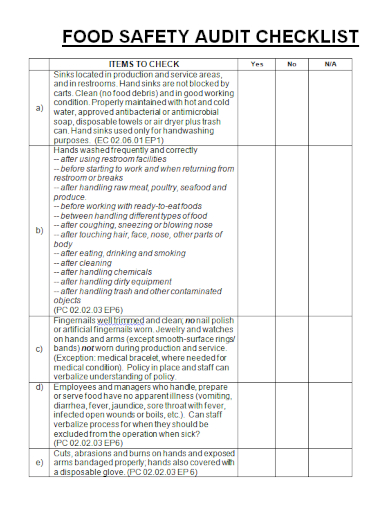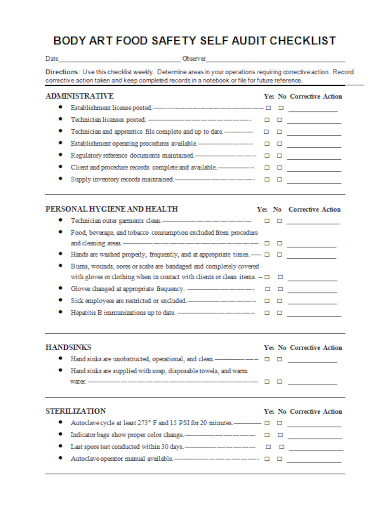Food safety should never be taken for granted, ever. It is crucial since it helps protect anyone from any risks of foodborne illnesses. When preparing, and storing food, it must be done following the safety procedures to ensure the food from getting contaminated and getting spoilt. A checklist can help ensure that the safety procedures are followed. Read the article to find out how to create a food safety audit checklist.
3+ Food Safety Audit Checklist Samples
1. Food Safety Audit Checklist
2. Food Safety Audit Verification Checklist
3. Sample Food Safety Audit Checklist
4. Food Safety Self Audit Checklist
Importance of Food Safety Audit Checklist
A food safety checklist is an important tool that food inspectors must use since it promotes food safety and sets a quality standard for all food handlers to ensure they prepare food safely. The checklist also helps identify food safety threats and risks and set actions to alleviate them. If no one follows to do food safety practices, the food is highly likely to get contaminated with harmful pathogens that could cause diseases to anyone who comes in contact with it. The risks associated with poor food safety are caused by improper food handling, poor hygiene of food handlers, and unsanitized kitchen materials and facilities.
How to Create a Food Safety Audit Checklist
1. Take Inventory
The first thing to do is grab a writing instrument such as a pen or pencil and a clipboard with a sheet of paper or a notebook. Walk around your kitchen and storage room and take a realistic inventory of the corners and nooks and write down the tasks that will make up your checklist.
2. List down all The Details That are Important in Your Checklist
The list below is an example of the details you need to put in the checklist. Make several columns to list down the categories that encompass the food safety audit and check the boxes if those were complied and mark with an ‘X’ if some of those were not complied.
- Hygiene of Food Rooms & Equipment: This category determines the cleanliness of the kitchen and the food storage room. It also checks to see if all equipment, surfaces, and tools used for preparing food are properly cleaned and sanitized and if the employees used the proper cleaning materials in cleaning the kitchen.
- Food Storage: This category determines if the food is stored properly. It inspects if the raw and cooked foo 8 d are stored separately, if the food has a proper label to check its freshness and validity if the dried goods are properly stored at the right room temperature if all food supplies delivery is then stored right away, and if the freezers are regularly defrosted and cleaned.
- Food Handling Practices: This category determines if the food is handled properly. For example, it checks if the ready-to-eat-food are prepared in a separate and clean area, if the food is not haphazardly mixed with raw foods or mixed with food containing allergens, if the staff observe the proper way of washing hands whenever they handle food if fresh food is washed thoroughly, etc.
- Personal Hygiene: This category determines the overall hygiene of the staff working in the kitchen. For example, it inspects if the staff is wearing the proper uniform in the workspace, if they are clean and presentable, if they washed their hands properly, if the washing area is clean and has the complete cleaning materials available, and if the toilet and changing area are properly cleaned and sanitized.
- Pest Control and Waste Control: This category determines the overall cleanliness of the kitchen. It checks if the kitchen has no pests or any animals roaming around or hiding in nooks and crannies if the kitchen is being pest-proofed if the garbage is properly segregated if the garbage bins are properly sanitized and if the dumpster outside the building is properly maintained and no food wastes are scattered around.
- Checks and Records Keeping: This category determines the more administrative work done in ensuring the kitchen is properly maintaining the basic health and food safety regulations and keeping that standard. For example, it checks if the records are up-to-date if there are updates with the list of suppliers, food handling methods, equipment used, and if there are any corrective actions taken with previous violations done in the kitchen.
FAQs
What are the four principles of food safety?
The four principles of food safety and food hygiene are cleaning, cross-contamination, chilling, and cooking.
What is the golden rule of food safety?
The golden rule of food safety is to wash hands when you’re handling food. Wash your hands before you start preparing food and after every interruption while you’re preparing food. When preparing raw food, wash your hands before you start handling other foods.
Wha
What are the different types of food hazards?
There are different types of food hazards and they can be present everywhere. These food hazards are:
- Microbiological hazards: These include bacteria, yeasts, molds, and viruses.
- Chemical hazards: These include water, food contact materials, cleaning agents, pest control substances, contaminants, pesticides, and even food additives.
- Physical hazards: These include any materials that get mixed with the food.
- Allergens: These include food with allergens that cause allergies and irritations to anyone who comes in contact with it.
If you see that the employees are non-compliant with any food safety policies on the day of the inspection process, assign corrective actions to the issues you identified. Make sure they will comply with your actions by setting a due date for them to correct it and tell them you will conduct a reinspection. Document the inspection process by taking photos of the facility. To help you get started on making your own checklist, download the free sample templates provided above as your reference!
Related Posts
FREE 13+ Equipment Checklists
FREE 11+ Laboratory Audit Report Samples
FREE 11+ Audit Schedule Samples
Checklists to Boost Efficiency and Reduce Mistakes
FREE 10+ Sample Risk Assessment Checklist
FREE 10+ Operating Procedures Samples
FREE 10+ Medication Checklist Samples
FREE 18+ Wedding Registry Checklists
FREE 14+ Sample Health and Safety Policy
FREE 11+ Retail Store Checklist Samples
FREE 11+ Weekly Checklist Templates
FREE 10+ Contractor Management Procedure Samples
FREE 10+ Retail Cleaning Checklist Samples
FREE 9+ Sample Safety Statement
How to Create a Checklist?
